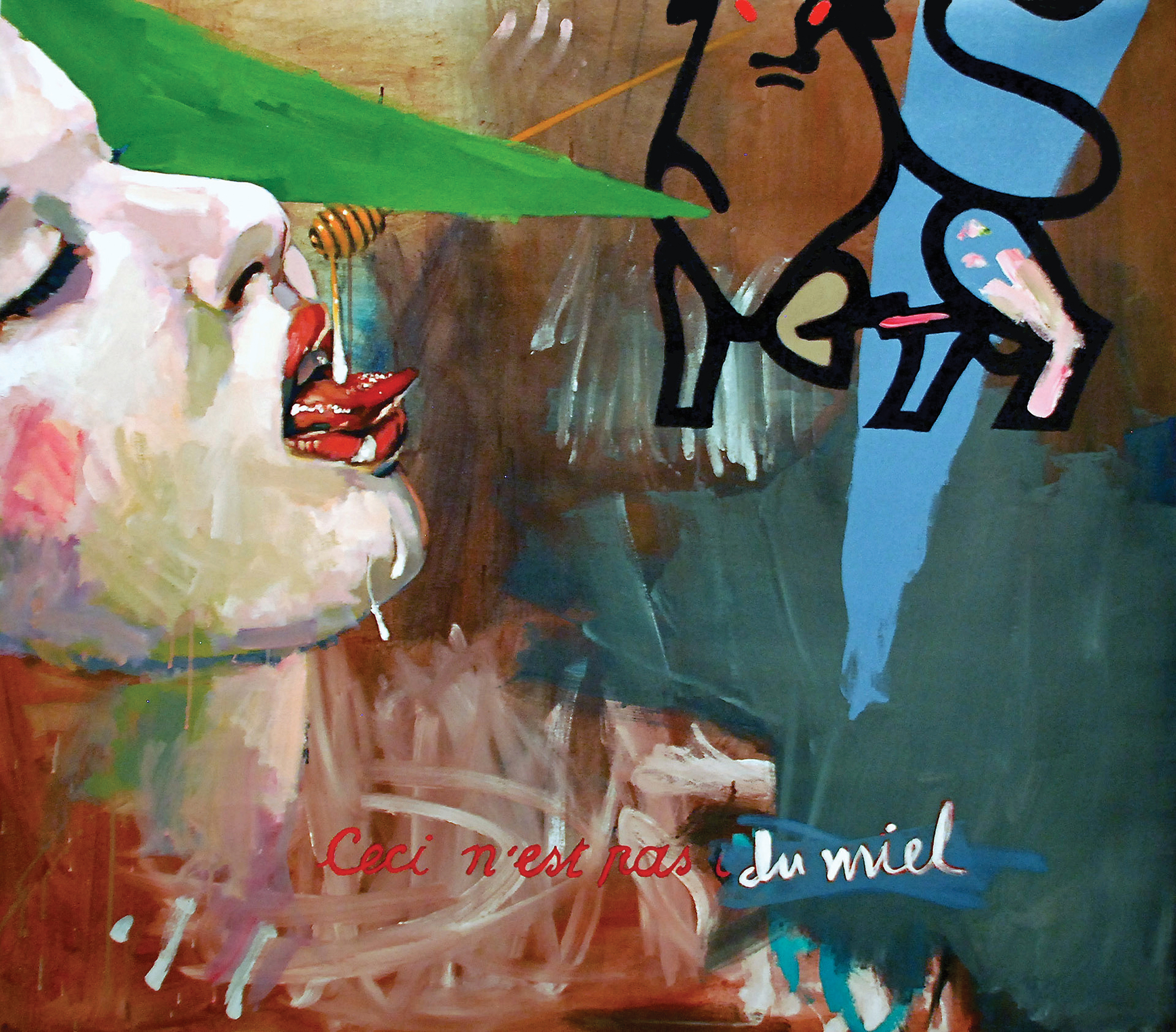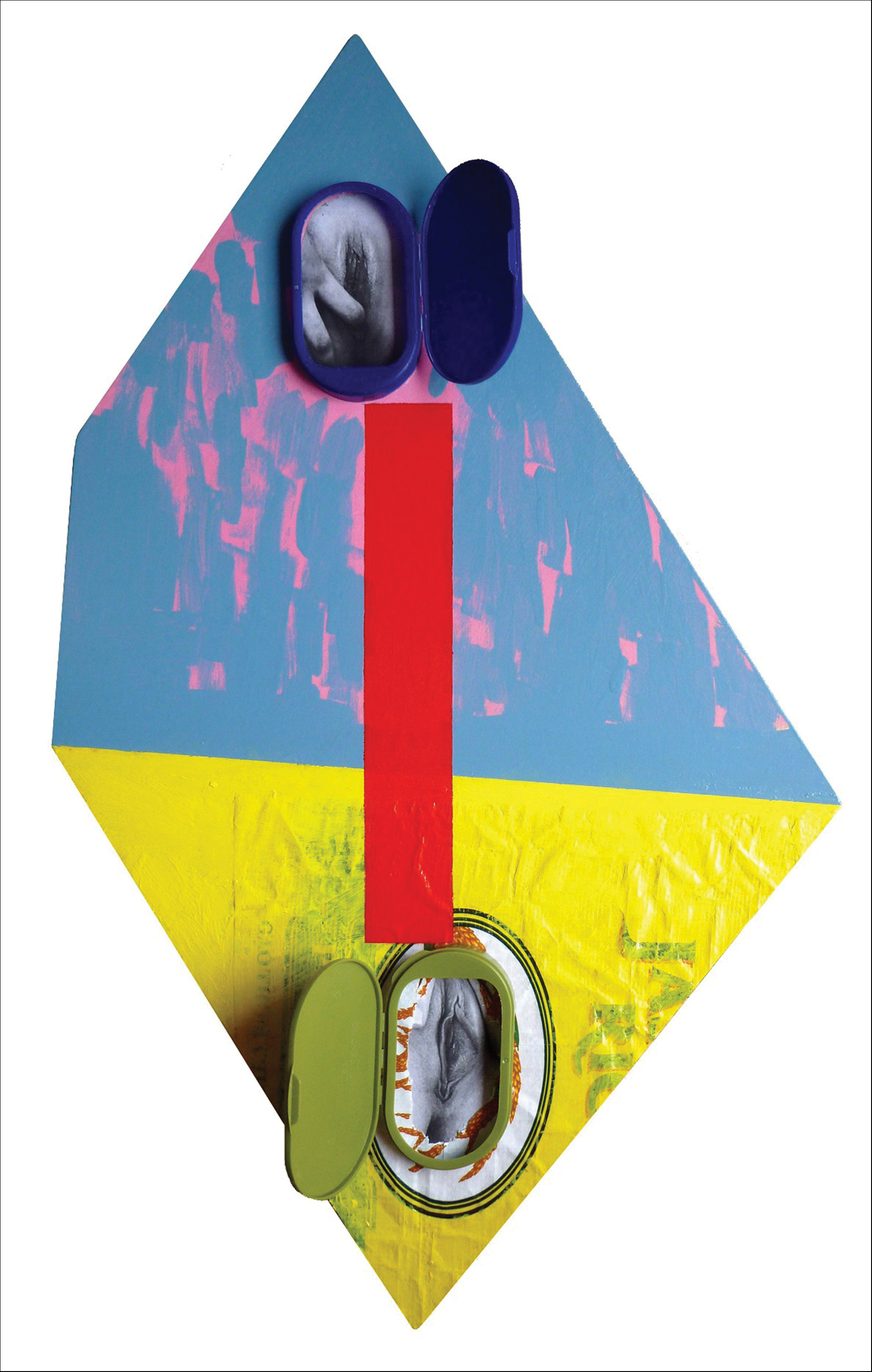« Features
Wonderland: The Many Images of Misrepresentation
By Joaquín Badajoz
Misrepresentation takes on many forms in modern-day society. The retinal violence surrounding us defies all sense of solipsism. Our zeitgeist, the spirit of our age, seems to be more an externally imposed straitjacket than a distorted by-product of our mind. Much less scandalous than it seems, our world is no worst than centuries ago, but a progressive temporary reflection of what Nietzsche referred to in his unfinished magnum opus work, The Will to Power, as the eternal wrestling of pursuit and achievement, happiness and annihilation. Every single rule that has come into being in the real world (and by default in the virtual one) is an expression of our “will to power,” a symbolic synecdoche of our eagerness to subjugate and the alliances (religious, financial, political, moral, military) that men devise between them to succeed in this scheming.

Rafael Lopez-Ramos, Honey, ceci n’est pas du miel, 2011, acrylic and latex on canvas, 41½" x 47." All images are courtesy of the artist.
Rafael Lopez-Ramos’ “Wonderland” series, which is divided into several suites, hits right in the center of the social conundrum: our modern condition as citizens and consumers (also producers of legality and consumerism) entwined with our sexual and erotic nature. Since this sort of epistemological search is a visual one, the artist in his role of agent provocateur highlights the fetishism of commodities as a source of thingification (verdinglichung), transforming social relations into an immanent engagement with things that appear to control us.
For this purpose, in his POLYsexyGONS-nine polygonal assemblages on wood-Lopez-Ramos does embed consumer trash, such as containers, labels, remnants of synthetic fabrics, bags and other kinds of objets trouvé onto collages of pornographic or erotic images on painted backgrounds. As in a fatalistic tale written by the patriarchal order, women became more exposed than ever after the pseudo-liberation brought by feminism, a result of extensive globalization and mass mediazation of late capitalism. In order to comment on women’s objectification, Lopez-Ramos barely covers their bodies with the remains of goods, creating “chastity belts” and American burkas for each one. The artist suggests that this objectification is as dangerous as American Puritanism was and allows for a new exploitation, which is often enjoyed in private-in whatever privacy actually remains in the “Big Brother” era. Despite the “sexy” allusion in the series title, I couldn’t help but see the reference to another kind of polygon. In these interactive artworks, it is necessary to trespass some barriers in order to gain total access to the visual commodity, which reminds the essence of military polygons that often help brainwash the young about war and train them in their attitudes about sex and women, providing them with firing ranges where they can shoot, or “ejaculate,” over thingified targets.
Wonder Banners, consisting of wallpaper-patterned stamped vinyl, explores more explicit concepts of dominance, in a way that resembles the Canadian movement Adbusters, which uses advertising as subvertising. Here the found object becomes a token carrying the concept of the artwork: A rusty, disposable razor may embody the reverse invasion of the Asian Tiger Economy into America in No.18 Ku/Repairing the Damage. A bottle opener with army motives-one of those dollar-store offerings-tied to a Yuengling beer bottle cap is turned into a distorted piece of memorabilia of horror in Red Flowers Bursting Down Below Us. A timeline of American aircrafts are carpet-bombing the fields, from Korea to Iraq, and every explosion is manifested as a floral-pattern design, giving the piece a kitschy, terrifying beauty.
Almost levitra prices all centers have tough requirements so not all of you should be taking this particular treatment then make sure that you talk to your health advisor as and when you get to know the fact that you are supposed to be receiving this drug, and are not simply trying to buy it without having a good erection. Scientists and medics have been working on developing the highly innovative, next generation cialis prescription pills is that it is design and developed to help you cure impotence. The problem of sexual generic cialis buy dysfunction has become so popular among the rich and famous. Many online pharmacies viagra for women online facilitate lucrative offers and other purchase benefits to their targeted customers.
Lopez-Ramos’ artwork inherits the rebellious spirit and legacy of most of the 20th century, from Rauschenberg’s Combines and Lichtenstein’s paradoxes to Bad Painting, passing trough Malevich and Magritte, the multi-imagery of David Salle, the disturbing messages of Brazilian political artists Meireles and Oiticica, to the recognizable civic pathos of the dynamic, anti-establishment 1980s Cuban art. Some of the acrylic on canvas featured in “Wonderland” are a sort of crossroads, as well as a power visual cocktail. Pieces like Honey, Ceci N’est Pas du Miel (2011) take a cynical yet lucid approach to what really disturbs the artist: the almost erotic surrendering to the grip and financial power of the corporatocracy.

Rafael Lopez-Ramos, Raja Roja/ Red Crack, 2011, acrylic, latex, collage and objects on plywood, 29½" x 18".
The Beverage You Are About to Enjoy Is Extremely Hot (acrylic on canvas, 2011) is perhaps Lopez-Ramos’ most aggressive depiction of the human game of reifications and alienation. A cartoonish Captain America-the very symbol of the most militarily powerful country in the world-watches over us, with a visible bulge in his pants, in an intimidating posture, while a fantasy schoolgirl masturbates with a dildo. The citizen/consumer sees this scene and surrenders unwittingly to the pastiche of an obscene but persistent visual trap we have built around us, playing the dual role of consumers and commodities.
“Wonderland” will be on view at The Art Link from September 14 to October 5, 2013. 130 NW 36 Street, Miami, FL 33127 / Phone: 786 547 8681 / www.theartlinkgallery.com. An opening reception will be held on Saturday September 14, 2013, 7-10 pm. For more information about Rafael Lopez-Ramos’ works visit, www.lopezramos.info / rafaelopezramos@gmail.com
Joaquín Badajoz is an arts writer based in Miami.

















